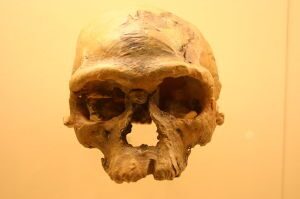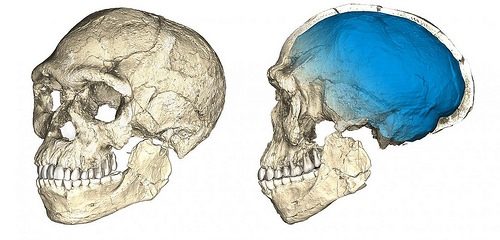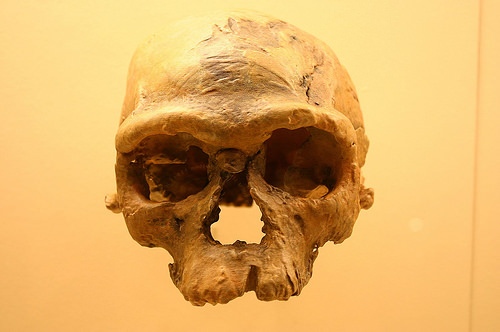
New fossil finds from the Jebel Irhoud archaeological site in Morocco have pushed back the origins of our species by 100,000 years, to at least 300,000 years ago, according to research conducted by Jean-Jacques Hublin of the Max Planck Institute for Evolutionary Anthropology in Leipzig, Germany, and Abdelouahed Ben-Ncer of the National Institute for Archaeology and Heritage (INSAP) in Rabat, Morocco. The new excavation uncovered 16 new Homo sapiens fossils along with stone tools and animal bones. The remains comprise skulls, teeth, and long bones of at least 5 individuals.. They also reveal what was on the menu for our oldest-known Homo sapiens ancestors 300,000 years ago.
Thermoluminescence dating of heated flints yielded an age of approximately 300,000 years ago—100,000 years earlier than the previously oldest Homo sapiens fossils.
Analysis of animal fossils found at the site provided additional evidence to support the date. Dating of rodent remains, for example, suggested they were 337,000 to 374,000 years old.
Pushing Back the Dates on Homo sapiens
Both genetic data of present day humans and fossil remains point to an African origin of our own species, Homo sapiens. Previously, the oldest securely dated Homo sapiens fossils were known from the site of Omo Kibish in Ethiopia, dated to 195 thousand years ago. At Herto, also in Ethiopia, a Homo sapiens fossil is dated to 160 thousand years ago. Until now, most researchers believed that all humans living today descended from a population that lived in East Africa around 200 thousand years ago. “We used to think that there was a cradle of mankind 200 thousand years ago in east Africa, but our new data reveal that Homo sapiensspread across the entire African continent around 300 thousand years ago. Long before the out-of-Africa dispersal of Homo sapiens, there was dispersal within Africa,” says palaeoanthropologist Jean-Jacques Hublin.
The Moroccan site of Jebel Irhoud has been well known since the 1960s for its human fossils and for its Middle Stone Age artefacts. However, the interpretation of the Irhoud hominins has long been complicated by persistent uncertainties surrounding their geological age. The new excavation project, which began in 2004, resulted in the discovery of new Homo sapiens fossils in situ, increasing their number from six to 22. These finds confirm the importance of Jebel Irhoud as the oldest and richest African Middle Stone Age hominin site documenting an early stage of our species. The fossil remains from Jebel Irhoud comprise skulls, teeth, and long bones of at least five individuals. To provide a precise chronology for these finds, researchers used the thermoluminescence dating method on heated flints found in the same deposits. These flints yielded an age of approximately 300 thousand years ago and, therefore, push back the origins of our species by one hundred thousand years.
“Well dated sites of this age are exceptionally rare in Africa, but we were fortunate that so many of the Jebel Irhoud flint artefacts had been heated in the past,” says geochronology expert Daniel Richter of the Max Planck Institute in Leipzig (Germany), now with Freiberg Instruments GmbH. Richter explains: “This allowed us to apply thermoluminescence dating methods on the flint artifacts and establish a consistent chronology for the new hominin fossils and the layers above them.” In addition, the team was able to recalculate a direct age of the Jebel Irhoud 3 mandible found in the 1960s. This mandible had been previously dated to 160 thousand years ago by a special electron spin resonance dating method. Using new measures of the radioactivity of the Jebel Irhoud sediments and as a result of methodological improvements in the method, this fossil’s newly calculated age is in agreement with the thermoluminescence ages and much older than previously realised. “We employed state of the art dating methods and adopted the most conservative approaches to accurately determine the age of Irhoud”, adds Richter.
The crania of modern humans living today are characterized by a combination of features that distinguish us from our fossil relatives and ancestors: a small and gracile face, and globular braincase. The fossils from Jebel Irhoud display a modern-looking face and teeth, and a large but more archaic-looking braincase. Hublin and his team used state-of-the-art micro computed tomographic scans and statistical shape analysis based on hundreds of 3D measurements to show that the facial shape of the Jebel Irhoud fossils is almost indistinguishable from that of modern humans living today. In contrast to their modern facial morphology, however, the Jebel Irhoud crania retain a rather elongated archaic shape of the braincase. “The inner shape of the braincase reflects the shape of the brain,” explains palaeoanthropologist Philipp Gunz from the Max Planck Institute for Evolutionary Anthropology in Leipzig. “Our findings suggest that modern human facial morphology was established early on in the history of our species, and that brain shape, and possibly brain function, evolved within the Homo sapiens lineage,” says Philipp Gunz. Recently, comparisons of ancient DNA extracted from Neanderthals and Denisovans to the DNA of present day humans revealed differences in genes affecting the brain and nervous system. Evolutionary shape changes of the braincase are therefore likely related to a series of genetic changes affecting brain connectivity, organization and development that distinguish Homo sapiensfrom our extinct ancestors and relatives.
The morphology and age of the fossils from Jebel Irhoud also corroborate the interpretation of an enigmatic partial cranium from Florisbad, South Africa, as an early representative of Homo sapiens. The earliest Homo sapiens fossils are found across the entire African continent: Jebel Irhoud, Morocco (300 thousand years), Florisbad, South Africa (260 thousand years), and Omo Kibish, Ethiopia (195 thousand years). This indicates a complex evolutionary history of our species, possibly involving the whole African continent.
“North Africa has long been neglected in the debates surrounding the origin of our species. The spectacular discoveries from Jebel Irhoud demonstrate the tight connections of the Maghreb with the rest of the African continent at the time of Homo sapiens‘ emergence”, says Abdelouahed Ben-Ncer.
Middle Stone Age Tools
The fossils were found in deposits containing animal bones showing evidence of having been hunted, with the most frequent species being gazelle. The stone tools associated with these fossils belong to the Middle Stone Age. The Jebel Irhoud artifacts show the use of Levallois prepared core techniques and pointed forms are the most common. Most stone tools were made from high quality flint imported into the site. Handaxes, a tool commonly found in older sites, are not present at Jebel Irhoud. Middle Stone Age artifact assemblages such as the one recovered from Jebel Irhoud are found across Africa at this time and likely speak to an adaptation that allowed Homo sapiens to disperse across the continent.
“The stone artifacts from Jebel Irhoud look very similar to ones from deposits of similar age in east Africa and in southern Africa” says Max Planck Institute archaeologist Shannon McPherron. “It is likely that the technological innovations of the Middle Stone Age in Africa are linked to the emergence of Homo sapiens.” The new findings from Jebel Irhoud elucidate the evolution of Homo sapiens, and show that our species evolved much earlier than previously thought. The dispersal of Homo sapiens across all of Africa around 300 thousand years is the result of changes in both biology and behaviour.
_______________________________________
These are two views of a composite reconstruction of the earliest known Homo sapiens fossils from Jebel Irhoud (Morocco) based on micro computed tomographic scans of multiple original fossils. Dated to 300 thousand years ago these early Homo sapiens already have a modern-looking face that falls within the variation of humans living today. However, the archaic-looking virtual imprint of the braincase (blue) indicates that brain shape, and possibly brain function, evolved within the Homo sapiens lineage. Credit: Philipp Gunz, MPI EVA Leipzig (License: CC-BY-SA 2.0)
_______________________________________
160,000-year-old Homo sapiens skull discovered at Jebel Irhoud. Ryan Somma, Wikimedia Commons
____________________________________________________
Game Hunters
Findings from the site revealed more than the age of the human fossils, however. Plenty of gazelle meat, with the occasional wildebeest, zebra and other game and perhaps the seasonal ostrich egg, were among the finds that revealed the diet of these early ancestors, says Teresa Steele, a paleoanthropologist at the University of California, Davis, who analyzed animal fossils at Jebel Irhoud.
Steele, who studies how food sources and environmental change influenced human evolution and migration, was part of the international research team that began excavating at the site in 2004. She is the co-author of one of the two papers featured on the cover of the June 8 issue of Nature: “Human origins: Moroccan remains push back date for the emergence of Homo sapiens.”
Steele sifted through hundreds of fossil bones and shells found at the site, identifying 472 of them to species as well as recording cut marks and breaks indicating which ones had been food for humans.
Most of the animal bones came from gazelles. Among the other remains, Steele also identified hartebeests, wildebeests, zebras, buffalos, porcupines, hares, tortoises, freshwater molluscs, snakes and ostrich egg shells.
Small game was a small percentage of the remains. “It really seemed like people were fond of hunting,” she said.
Cuts and breaks on long bones indicate that humans broke them open, likely to eat the marrow, she said. Leopard, hyena and other predators’ fossils were among the finds, but Steele found little evidence that the nonhuman predators had gnawed on the gazelle and other prey.
Steele said the findings support the idea that the Middle Stone Age began just over 300,000 years ago, and that important changes in modern human biology and behaviour were taking place across most of Africa then.
“In my view, what it does is to continue to make it more feasible that North Africa had a role to play in the evolution of modern humans.”
Adapted and edited from three article sources: University of California – Davis , Griffith University , and Max Planck Gesellschaft news releases
_______________________________________________
Receive 30 days free access to the popular new CuriosityStream lineup of documentaries on science, history, nature, and technology as a new Popular Archaeology premium subscriber.
___________________________________________
Travel and learn with Far Horizons.
____________________________________________
This richly illustrated issue includes the following stories: Recent findings shedding new light on the whereabouts of the remains of Philip of Macedon, father of Alexander the Great; how an archaeologist-sculptor is bringing bones of the dead back to life; archaeologists uncovering town life at the dawn of civilization; an exclusive interview with internationally acclaimed archaeologist James M. Adovasio about what makes the Meadowcroft Rockshelter prominent in the ongoing search for the first Americans; what archaeologists are finding at the site of the ancient city of Gath, the home town of the biblical Philistine giant, Goliath; and how scientists are redrawing the picture of human evolution in Europe. Find it on Amazon.com.








